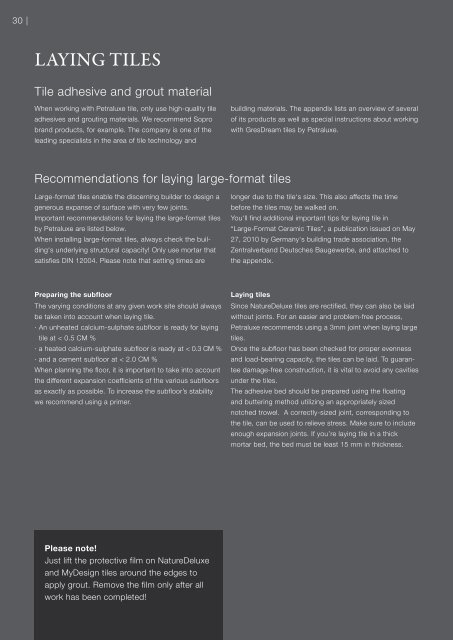Fliesen mit Format tiles with style Carrelage de ... - petraluxe.de
Fliesen mit Format tiles with style Carrelage de ... - petraluxe.de
Fliesen mit Format tiles with style Carrelage de ... - petraluxe.de
Create successful ePaper yourself
Turn your PDF publications into a flip-book with our unique Google optimized e-Paper software.
30 |<br />
laying <strong>tiles</strong><br />
Tile adhesive and grout material<br />
When working <strong>with</strong> Petraluxe tile, only use high-quality tile<br />
adhesives and grouting materials. We recommend Sopro<br />
brand products, for example. The company is one of the<br />
leading specialists in the area of tile technology and<br />
Recommendations for laying large-format <strong>tiles</strong><br />
Large-format <strong>tiles</strong> enable the discerning buil<strong>de</strong>r to <strong>de</strong>sign a<br />
generous expanse of surface <strong>with</strong> very few joints.<br />
Important recommendations for laying the large-format <strong>tiles</strong><br />
by Petraluxe are listed below.<br />
When installing large-format <strong>tiles</strong>, always check the building‘s<br />
un<strong>de</strong>rlying structural capacity! Only use mortar that<br />
satisfies DIN 12004. Please note that setting times are<br />
Preparing the subfloor<br />
The varying conditions at any given work site should always<br />
be taken into account when laying tile.<br />
· An unheated calcium-sulphate subfloor is ready for laying<br />
tile at < 0.5 CM %<br />
· a heated calcium-sulphate subfloor is ready at < 0.3 CM %<br />
· and a cement subfloor at < 2.0 CM %<br />
When planning the floor, it is important to take into account<br />
the different expansion coefficients of the various subfloors<br />
as exactly as possible. To increase the subfloor’s stability<br />
we recommend using a primer.<br />
Please note!<br />
Just lift the protective film on NatureDeluxe<br />
and MyDesign <strong>tiles</strong> around the edges to<br />
apply grout. Remove the film only after all<br />
work has been completed!<br />
building materials. The appendix lists an overview of several<br />
of its products as well as special instructions about working<br />
<strong>with</strong> GresDream <strong>tiles</strong> by Petraluxe.<br />
longer due to the tile‘s size. This also affects the time<br />
before the <strong>tiles</strong> may be walked on.<br />
You‘ll find additional important tips for laying tile in<br />
“Large-<strong>Format</strong> Ceramic Tiles”, a publication issued on May<br />
27, 2010 by Germany‘s building tra<strong>de</strong> association, the<br />
Zentralverband Deutsches Baugewerbe, and attached to<br />
the appendix.<br />
Laying <strong>tiles</strong><br />
Since NatureDeluxe <strong>tiles</strong> are rectified, they can also be laid<br />
<strong>with</strong>out joints. For an easier and problem-free process,<br />
Petraluxe recommends using a 3mm joint when laying large<br />
<strong>tiles</strong>.<br />
Once the subfloor has been checked for proper evenness<br />
and load-bearing capacity, the <strong>tiles</strong> can be laid. To guarantee<br />
damage-free construction, it is vital to avoid any cavities<br />
un<strong>de</strong>r the <strong>tiles</strong>.<br />
The adhesive bed should be prepared using the floating<br />
and buttering method utilizing an appropriately sized<br />
notched trowel. A correctly-sized joint, corresponding to<br />
the tile, can be used to relieve stress. Make sure to inclu<strong>de</strong><br />
enough expansion joints. If you’re laying tile in a thick<br />
mortar bed, the bed must be least 15 mm in thickness.<br />
Laying floor <strong>tiles</strong><br />
1. Vacuum the floor 2. Fasten edge insulating strips along the<br />
base of the wall<br />
It takes just a few steps to lay the <strong>tiles</strong> on level floors:<br />
first, vacuum the floor to remove all dust. Next, apply edge<br />
insulation strips along the base of the walls. Apply primer<br />
4.1. Apply premixed mortar 4.2. Spread premixed mortar evenly<br />
(watch the drying time)<br />
To level any unevenness, premixed mortar (e.g. Sopro)<br />
should be poured onto the dried, primed surface and<br />
spread evenly <strong>with</strong> a smoothing trowel and spiked roller.<br />
Once the subfloor has been prepared, put down a contact<br />
layer of a flexible adhesive (e.g. SoproVario- Flex’ XL,<br />
6. Lay down <strong>tiles</strong><br />
(optimum joint width: 3 mm)<br />
Lay down the prepared tile into the fresh adhesive bed,<br />
precisely on its final location. Optimum joint width is 3 mm.<br />
3. Apply primer (watch the drying time!)<br />
(e.g. Sopro) <strong>with</strong> a lambskin roller to the clean, slightly<br />
ground calcium-sulphate subfloor.<br />
5. Apply tile adhesive on floor/wall and tile,<br />
using the floating and buttering method<br />
especially formulated for large-format <strong>tiles</strong>). Next,<br />
create a ridged bed using a notched trowel. Apply a<br />
contact layer on the back si<strong>de</strong> of the porcelain tile using<br />
a flexible adhesive (e.g. SoproVario- Flex’ XL).<br />
7. Align <strong>tiles</strong> 8. Apply grout and clean the surface<br />
After grouting the joints and the appropriate curing time,<br />
clean the <strong>tiles</strong> <strong>with</strong> a cement haze remover.<br />
| 31<br />
english


